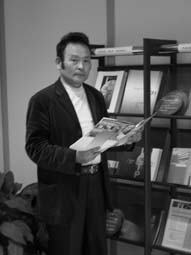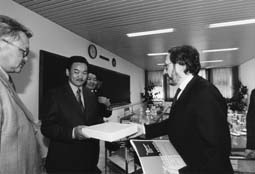Personal tools
News from ICTP 100 - Features - Mongolia

The 'sandwich programme' is the latest in a series of cooperative activities between ICTP and Mongolia's scientific community that date back the Centre's earliest days.
From Here To Mongolia
It's a long way from Trieste,
Italy, to Ulanbataar, Mongolia--some 8000 kilometers. But the
ICTP 'sandwich programme,' which enables promising young students
to spend a year of study in Trieste and then return home to complete
their doctorate degrees, is bringing the scientific communities
in both places closer together. At the same time, it's helping
to build a strong foundation for the future of science in Mongolia.
"I'm likely to become the first laser optics specialist in
Mongolia," says Tuvshintugs Damdinsuren, who arrived in Trieste
last September from the Mongolia University of Science and Technology
with his master's degree in physics already in hand and eager
to take the next steps he will need to earn a doctorate.

Tuvshintugs Damdinsuren
To reach his ultimate goal, Damdinsuren will spend a year in Italy
devoting much of his time studying and attending courses at ICTP
while conducting laser experiments at the Elettra synchrotron
light facility's laser and fibre optics laboratory, located on
the campus of Area Science Park less than 15 kilometers northeast
of the Centre. "Because my university does not have a programme
in laser physics and nonlinear optics," he notes, "it
would be extremely difficult for me to pursue my research interests
if I remained in Mongolia."
The 'sandwich' programme, which is sponsored by the International
Atomic Energy Agency (IAEA) in Vienna, Austria, is just one of
several Centre-based activities that have benefitted Mongolia's
scientific community for nearly four decades.
For example, since the Centre's inception in 1964, some 50 Mongolian
scientists have attended ICTP research and training activities,
ranging from cosmology to condensed matter physics to the mathematics
of economics. The knowledge and skills that they have acquired
by participating in the Centre's conferences, seminars, schools
and workshops have served them well when they returned to their
universities to resume their teaching and research responsibilities.
At the same time, a total of eight young Mongolian scientists
have received a certificate from ICTP's year-long Diploma Course
programme, which was launched in 1991.
Horgolkhuu Odbadrakh, for example, attended the Diploma Course
in condensed matter physics in 1994-1995 and Agvaanluvsan Undraa
was a member of the Diploma Course class of 1996-1997 in high
energy physics. Odbadrakh went on to receive a masters degree
at the University of South Wales in Sydney in Australia and has
returned to the National University of Mongolia to teach physics
and to continue his research in the classical states of matter
and thermodynamics. Undraa, meanwhile, is currently studying for
her Ph.D. in physics at North Carolina State University, USA,
where she was awarded an international graduate student fellowship
in 2000.

Oidov Lhagva
"For more than 40 years," notes Oidov Lhagva, distinguished
professor of theoretical physics at the National University of
Mongolia who last visited the Centre in February, "ICTP has
provided Mongolian scientists with a link to the outside world."
The President of Mongolia, Natsagyn Bagabandi, warmly acknowledged
the role that ICTP has played in the development of his nation's
scientific community when he visited the Centre in summer 2000.

Natsagyn Bagabandi, President of Mongolia, at ICTP in 2000
That role may be more important than ever as Mongolia's universities
continue to make a slow but steady shift from a Soviet-style system
of higher education to a Western-style system of higher education.
Today the National University of Mongolia has about 20 professors
and lecturers in its physics department, half of whom were trained
at Moscow State University or Dubna Joint Institute for Nuclear
Research before the collapse of communism in the late 1980s. These
instructors are responsible for teaching physics to some 800 undergraduate
and 70 graduate students.
"The university is increasingly shedding its Soviet dress
for more Western attire," explains Lhagva, "but sometimes
the substantive changes have been slower than the stylistic ones.
Faculty and student visits to Trieste-and specifically to ICTP-have
helped facilitate the transition by enabling us to keep in close
contact with the global scientific community."
"Mongolia is a remote country," Lhagva continues, "and
even under the best of circumstances it is not easy for scientists
to develop meaningful and lasting contacts with colleagues in
other countries. The Centre has provided a sturdy bridge of communication
during this dramatic period of transition."
Another challenge facing Mongolia's scientific community is that
it has yet to train a sufficient number of physicists to ensure
that all basic fields of study can be offered to students.
For example, the National University of Mongolia has an ample
number of professors and lecturers trained in nuclear and condensed
matter physics, but its faculty in high energy physics remains
slim and its faculty in quantum physics and nonlinear optics is
too small to even offer an undergraduate degree in these subfields,
which are currently among the most vigorous in physics.
ICTP helps Mongolia's physics community meet these shortcomings
in two important ways.
First, the Centre's research and training activities, which number
about 40 each year in a variety of subjects related to physics
and mathematics, fill an important void for scientists from Mongolia
and other nations that face the same set of problems. Although
the Centre's activities will never compensate for the lack of
a degree-granting subfield at a national university, they nevertheless
enable scientists to be introduced to subjects that they would
not have an opportunity to learn about if their classroom work
and studies were restricted to institutions within their home
countries.
Second, the Centre's Diploma Course and sandwich programmes provide
more in-depth knowledge in research areas that students may subsequently
choose as the focal point of their scientific careers. If these
students return home--as Damdinsuren plans to do after his year
of study in Trieste--then people like him could become the first
in a long line of teachers and researchers in these fields. In
the process, subjects once absent would be added to the curriculum
and subdisciplines once weak would become strong. That, in essence,
is how the long-discussed desire for capacity building could become
a reality.
While in Trieste, Damdinsuren has devoted his time to the study
of fundamental laser-optics theories and to basic experiments
involving ultrashort laser-pulse generation and measurements.
Such efforts could lead to a better understanding of the complex
nature of protein behaviour. In fact, deciphering a protein's
behavioural patterns--and, more importantly, how such behaviour
affects a protein's structure and function--requires both textbook
theoretical knowledge as well as an ability to manipulate the
diamond tips found on atomographic micromachines. Put more simply,
it requires both intellectual insight and manual dexterity.
The classroom experience at ICTP, complemented by the laboratory
experiments conducted at Elettra, is enabling Damdinsuren
to meet his goals by deepening both his scientific understanding
and honing his experimental techniques--a blending of knowledge
and know-how that should prove valuable throughout his entire
career.
As for the future, Damdinsuren hopes that his acquired skills
will help convince funding agencies that the construction of a
small educational and research laser laboratory at the Mongolian
University of Science and Technology. He estimates such a facility
would cost about US$100,000 (if it was built largely with equipment
and parts salvaged from existing laboratories in Europe or the
United States).
"Providing access to such a machine in Mongolia," Lhagva
notes, "would bring both ICTP's and Mongolia's scientific
community one step nearer their shared goal: To create a self-sustaining
community of homegrown scholars with the knowledge and experience
necessary to interact with like-minded colleagues from around
the world."
SANDWICHING FOR SUCCESS
The ICTP 'sandwich' programme, launched in 1995 with funding
from the International Atomic Energy Agency (IAEA) in Vienna (IAEA
remains the programme's major benefactor), has provided fellowships
to about 10 young researchers each year, mostly in the field of
laser and atomic physics. The primary aim of the programme, which
requires participants to remain enrolled in their home universities
while taking a one-year course of study in Trieste, is to encourage
students to pursue their careers in their home countries once
they have earned their doctorates. The programme seeks to promote
state-of-the-art training without encouraging multi-year visits
abroad, a factor that many experts believe has contributed to
the 'brain-drain' problem in the past. For additional information
about the ICTP 'sandwich programme,' contact the Office of External
Activities at oea@ictp.trieste.it.